Sustainable Livestock Production in Nepal: A Focus on Animal Nutrition Strategies
Abstract
1. Background
2. Methodology
2.1. Data and Calculations Underlying Projections for Milk Production and Demands
2.2. Data and Calculations Underlying Projections for Meat Production and Demand
3. Nepalese Livestock Production
4. Current Status
4.1. Major Milk-Producing Animals in Nepal
4.1.1. Cattle
4.1.2. Buffalo
4.2. Major Meat-Producing Animals in Nepal
4.2.1. Buffalo
4.2.2. Goat and Sheep
4.2.3. Pigs
4.2.4. Poultry
4.3. Wool Production in Nepal
5. Future Perspectives
5.1. Productive and Sustainable Livestock Systems to Alleviate Poverty
5.2. Alternative Livestock Feeding Strategies
Species-Specific Feeding Strategies
5.3. Feeding Strategies for Reduced Climate Impact
6. Future Livestock Policies
6.1. Animal Feed—A Pivotal Component of the Future Livestock Policies
6.2. Capacity and Infrastructure Building of Research Institutions
6.3. Research–Academia–Industry (RAI) Collaborations
7. Conclusions
Supplementary Materials
Author Contributions
Funding
Institutional Review Board Statement
Informed Consent Statement
Data Availability Statement
Acknowledgments
Conflicts of Interest
References
- Steinfeld, H.; Gerber, P.; Wassenaar, T.; Castel, V.; De Haan, C. Livestock’s Long Shadow: Environmental Issues and Options; FAO: Rome, Italy, 2006. [Google Scholar]
- FAO. The Future of Food and Agriculture—Alternative Pathways to 2050; FAO: Rome, Italy, 2018; p. 224. [Google Scholar]
- Herrero, M.; Thornton, P.K.; Gerber, P.; Reid, R.S. Livestock, livelihoods and the environment: Understanding the trade-offs. Curr. Opin. Environ. Sustain. 2009, 1, 111–120. [Google Scholar] [CrossRef]
- Alexandratos, N.; Bruinsma, J. World Agriculture towards 2030/2050: The 2012 Revision; ESA Working paper; FAO: Rome, Italy, 2012. [Google Scholar]
- Mizrahi, I.; Wallace, R.J.; Moraïs, S. The rumen microbiome: Balancing food security and environmental impacts. Nat. Rev. Microbiol. 2021, 19, 553–566. [Google Scholar] [CrossRef] [PubMed]
- Höglund-Isaksson, L. Global anthropogenic methane emissions 2005–2030: Technical mitigation potentials and costs. Atmos. Chem. Phys. 2012, 12, 9079–9096. [Google Scholar] [CrossRef]
- Henderson, B.; Golub, A.; Pambudi, D.; Hertel, T.; Godde, C.; Herrero, M.; Cacho, O.; Gerber, P. The power and pain of market-based carbon policies: A global application to greenhouse gases from ruminant livestock production. Mitig. Adapt. Strateg. Glob. Change 2018, 23, 349–369. [Google Scholar] [CrossRef]
- Mehrabi, Z.; Gill, M.; Wijk, M.v.; Herrero, M.; Ramankutty, N. Livestock policy for sustainable development. Nat. Food 2020, 1, 160–165. [Google Scholar] [CrossRef]
- Devendra, C.; Thomas, D. Crop–animal systems in Asia: Importance of livestock and characterisation of agro-ecological zones. Agric. Syst. 2002, 71, 5–15. [Google Scholar] [CrossRef]
- Herrero, M.; Grace, D.; Njuki, J.; Johnson, N.; Enahoro, D.; Silvestri, S.; Rufino, M.C. The roles of livestock in developing countries. Animal 2013, 7 (Suppl. S1), 3–18. [Google Scholar] [CrossRef]
- Population Reference Bureau. 2012 World Population Data Sheet. Available online: https://www.prb.org/wp-content/uploads/2012/07/2012-population-data-sheet_eng.pdf (accessed on 12 November 2021).
- Thornton, P. Mapping Poverty and Livestock in the Developing World; ILRI (aka ILCA and ILRAD): Nairobi, Kenya, 2002; Volume 1. [Google Scholar]
- Mottet, A.; Tempio, G. Global poultry production: Current state and future outlook and challenges. World’s Poult. Sci. J. 2017, 73, 245–256. [Google Scholar] [CrossRef]
- Enahoro, D.; Mason-D’Croz, D.; Mul, M.; Rich, K.M.; Robinson, T.P.; Thornton, P.; Staal, S.S. Supporting sustainable expansion of livestock production in South Asia and Sub-Saharan Africa: Scenario analysis of investment options. Glob. Food Secur. 2019, 20, 114–121. [Google Scholar] [CrossRef]
- MOALD. Statistical Information on Nepalese Agriculture (2016/2017); Ministry of Agriculture and Livestock Development: Kathmandu, Nepal, 2017.
- MOALD. Statistical Information on Nepalese Agriculture (2018/2019); Ministry of Agriculture and Livestock Development: Kathmandu, Nepal, 2019.
- Muehlhoff, E.; Bennett, A.; McMahon, D. Milk and Dairy Products in Human Nutrition; FAO: Rome, Italy, 2013. [Google Scholar]
- CBS. National Population and Housing Census 2011 (Population Projection 2011–2031); CBS: Kathmandu, Nepal, 2014; pp. 1–78.
- Sanwal, B.D. Nepal—An Introduction. Available online: https://aspace.repository.cam.ac.uk/bitstream/handle/1810/242729/bot_03_02_04.pdf?sequence=1&isAllowed=y (accessed on 8 December 2021).
- MOALD. Statistical Information on Nepalese Agriculture; Ministry of Agriculture and Livestock Development: Kathmandu, Nepal, 2016.
- ADS. Agriculture Development Strategy (ADS) 2015–2035; Government of Nepal, Ministry of Agricultural Development: Kathmandu, Nepal, 2015.
- Wilson, R.T. Animal genetic resources and domestic animal diversity in Nepal. Biodivers. Conserv. 1997, 6, 233–251. [Google Scholar] [CrossRef]
- CBS. Central Bureau of Statistics—A Compendium of National Statistical System of Nepal; National Planning Commission Secretariat: Kathmandu, Nepal, 2017.
- MOF. Econmic Survery; Government of Nepal, Ministry of Finance: Kathmandu, Nepal, 2017.
- Moioli, B.; Borghese, A. Buffalo Breeds and Management Systems. Buffalo Production and Research; FAO: Rome, Italy, 2005; pp. 51–76. [Google Scholar]
- Devendra, C. Small ruminants in Asia; Contribution to food security, poverty alleviation and opportunities for productivity enhancement. In Proceedings of the International Workshop on Small Ruminant Production and Development, South East Asia, Ho Chi Minh City, Vietnam, 2–4 March 2005; pp. 19–32. [Google Scholar]
- Rajwar, N.B. National Goat Development Strategies and Outcomes; National Agriculture Research Council (NARC): Kathmandu, Nepal, 2013.
- Shrestha, B.S.; Pokharel, P.K. Potential and Performances of Goat Breeds and Future Breeding Strategies for Commercialization of Goat Production in Nepal; National Agriculture Research Council (NARC): Kathmandu, Nepal, 2012.
- Oli, K.P.; Gatenby, R.M. Goat and sheep production in the hills and mountains of Eastern Nepal. Int. J. Anim. Sci. 1990, 5, 41–47. [Google Scholar]
- Rauniyar, G.; Upreti, C.; Gavigan, R.; Parker, W. Constraints to Sheep Farming in Nepal: Development Challenge for Poverty Alleviation. Asian-Australas. J. Anim. Sci. 2000, 13, 1162–1172. [Google Scholar] [CrossRef]
- Nidup, K.; Joshi, D.D.; Gongora, J.; Moran, C. Farming and biodiversity of indigenous pigs in Nepal. Biodiversity 2010, 11, 26–33. [Google Scholar] [CrossRef]
- FAO. Poultry Sector Nepal; FAO Animal Production and Health Livestock Country Reviews; No. 8.; FAO: Rome, Italy, 2014. [Google Scholar]
- Gorkhali, N.A.; Sherpa, C.; Kolachhapati, M.R.; Pokharel, B.R.; Bhattarai, N.; Sapkota, S. Intermixing of Commercial Pure Breed Chickens with Indigenous (Sakini) Breed of Nepal. J. Nepal Agric. Res. Counc. 2021, 7, 92–96. [Google Scholar] [CrossRef]
- Osti, R.; Zhou, D.; Singh, V.; Bhattarai, D.; Chaudhary, H. An economic analysis of poultry egg production in Nepal. Pak. J. Nutr. 2016, 15, 715–724. [Google Scholar] [CrossRef]
- Sapkota, S.; Kolachhapati, M.; Devkota, N.; Gorkhali, N.; Bhattarai, N. Evaluation of Egg Laying and Egg Quality Parameters of Local. J. Agric. For. Univ. 2017, 1, 181. [Google Scholar]
- Osti, R.; Bhattarai, D.; Chaudhary, H.; Singh, V. Poultry production in Nepal: Characteristics, productivity and constraints. Int. J. Appl. Sci. Biotechnol. 2017, 5, 222–226. [Google Scholar] [CrossRef]
- Pradhanang, U.B.; Pradhanang, S.M.; Sthapit, A.; Krakauer, N.Y.; Jha, A.; Lakhankar, T. National Livestock Policy of Nepal: Needs and Opportunities. Agriculture 2015, 5, 103–131. [Google Scholar] [CrossRef]
- Upreti, C.; Shrestha, B. Sheep and Wool Production Systems in Nepal; FY 2052/53 (1995/96); Sheep and Goat Research Program, Nepal Agricultural Research Council: Jumla, Nepal, 1996.
- Paudel, M.N. Prospects and limitations of agriculture industrialization in Nepal. Agron. J. Nepal 2016, 4, 38–63. [Google Scholar] [CrossRef][Green Version]
- CBS. National Population and Housing Census 2011; National Report; Government of Nepal, Central Bureau of Statistics: Kathmandu, Nepal, 2012.
- CBS. Nepal Living Standards Survey 2010/11 (NLSS); Dataset; Central Bureau of Statistics: Kathmandu, Nepal, 2011.
- Pica-Ciamarra, U.; Tasciotti, L.; Otte, J.; Zezza, A. Livestock Assets, Livestock Income and Rural Households: Evidence from Household Surveys; FAO: Rome, Italy, 2011. [Google Scholar]
- Lokshin, M.; Bontch-Osmolovski, M.; Glinskaya, E. Work-related migration and poverty reduction in Nepal. Rev. Dev. Econ. 2010, 14, 323–332. [Google Scholar] [CrossRef]
- Wagle, U.R.; Devkota, S. The impact of foreign remittances on poverty in Nepal: A panel study of household survey data, 1996–2011. World Dev. 2018, 110, 38–50. [Google Scholar] [CrossRef]
- Becker, G.S. Livestock Feed Costs: Concerns and Options; Congressional Research Service, Library of Congress: Washington, DC, USA, 2008.
- Abrahamsen, F.W.; Gurung, N.K.; Abebe, W.; Reddy, G.P.; Mullenix, K.; Adhikari, S. Effects of feeding varying levels of hempseed meal on dry matter intake, rumen fermentation, in vitro digestibility, blood metabolites, and growth performance of growing meat goats. Appl. Anim. Sci. 2021, 37, 681–688. [Google Scholar] [CrossRef]
- Chemjong, P.B. Economic value of urea-treated straw fed to lactating buffaloes during the dry season in Nepal. Trop. Anim. Health Prod. 1991, 23, 147–154. [Google Scholar] [CrossRef]
- Upreti, C.; Kuwar, B.; Panday, S. Possible use of crop residues supplemented with urea and molasses in goat diets. Nepal J. Sci. Technol. 2006, 7, 59–64. [Google Scholar] [CrossRef]
- Malik, K.; Tokkas, J.; Anand, R.C.; Kumari, N. Pretreated rice straw as an improved fodder for ruminants-An overview. J. Appl. Nat. Sci. 2015, 7, 514–520. [Google Scholar] [CrossRef]
- Khandaker, Z.; Uddin, M. Cost-effective preservation technique of green fodder and its impact on quality of silage. Livest. Res. Rural. Dev. 2013, 25, 233–243. [Google Scholar]
- Shrestha, R.; Tiwari, B. Nutritional value and tannin content of some common fodder tree species of the western hills of Nepal. In Proceedings of the Fourth Meeting of the Working Group on Fodder Trees, Forest fodder and leaf litter, Kathmandu, Nepal, 3–5 December 1991; FRD occasional paper. p. 92. [Google Scholar]
- Upreti, S.; Devkota, N. Ranking of Fodder Tree Species and Their Biomass Production in the Hills and Mountain of Nepal. J. Agric. For. Univ. 2017, 1, 171. [Google Scholar]
- Khanal, R.C.; Subba, D.B. Nutritional evaluation of leaves from some major fodder trees cultivated in the hills of Nepal. Anim. Feed. Sci. Technol. 2001, 92, 17–32. [Google Scholar] [CrossRef]
- Khanal, R.; Upreti, C. Evaluation of selected species of tree fodders cultivated for feeding ruminants in the hills of Nepal. Pak. J. Nutr. 2008, 7, 297–302. [Google Scholar] [CrossRef][Green Version]
- Guèye, E. Family poultry research and development in low-income food-deficit countries: Approaches and prospects. J. Outlook Agric. 2002, 31, 13–21. [Google Scholar] [CrossRef]
- Hellin, J.; Erenstein, O. Maize-poultry value chains in India: Implications for research and development. J. New Seeds 2009, 10, 245–263. [Google Scholar] [CrossRef]
- Govind, K.; Karki, T.B.; Shrestha, J.; Achhami, B.B. Status and prospects of maize research in Nepal. J. Maize Res. Dev. 2015, 1, 1–9. [Google Scholar]
- NMRP. Annual Report 2073/74 (2016/17); National Maize Research Program (NMRP), NARC: Rampur, Nepal, 2017.
- Gharti, D.; Darai, R.; Subedi, S.; Sarker, A.; Kumar, S. Grain legumes in Nepal: Present scenario and future prospects. World J. Agric. Res. 2014, 2, 216–222. [Google Scholar]
- Ravindran, V.; Blair, R. Feed resources for poultry production in Asia and the Pacific. II. Plant protein sources. World’s Poult. Sci. J. 1992, 48, 205–231. [Google Scholar] [CrossRef]
- Shrestha, R.; Neupane, R.; Adhikari, N. Status and future prospects of pulses in Nepal. In Proceedings of the Regional Workshop on Pulse Production, Nepal Agricultural Research Council (NARC), Kathmandu, Nepal, 24–25 October 2011; pp. 24–25. [Google Scholar]
- Thapa, V.K. An Inventory of Nepal’s Insects; IUCN-The World Conservation Union: Kathmandu, Nepal, 1997. [Google Scholar]
- Harper, P. Capniidae, Leuctridae, and Perlidae (Plecoptera) from Nepal. J. Orient. Insects 1977, 11, 53–62. [Google Scholar] [CrossRef]
- Moreki, J.; Tiroesele, B.; Chiripasi, S. Prospects of utilizing insects as alternative sources of protein in poultry diets in Botswana: A review. J. Anim. Sci. Adv. 2012, 2, 649–658. [Google Scholar]
- Khusro, M.; Andrew, N.; Nicholas, A. Insects as poultry feed: A scoping study for poultry production systems in Australia. World’s Poult. Sci. J. 2012, 68, 435–446. [Google Scholar] [CrossRef]
- Dhakal, H.; Sah, R.; Karki, D.N.; Yadav, J.; Tiwari, M.R. Replacement effects of soybean meal with different levels of sunflower meal with or without enzyme on performance of Cobb-500 broilers. Nepal. J. Agric. Sci. 2015, 13, 29–37. [Google Scholar]
- Paudel, D.R.; Dhakal, P.; Timsina, K.P.; Dahal, A. Azolla as an Economic Substitute to Soybean Based Feed for Poultry. Int. J. Appl. Sci. Biotechnol. 2015, 3, 619–625. [Google Scholar] [CrossRef][Green Version]
- McMichael, A.J.; Powles, J.W.; Butler, C.D.; Uauy, R. Food, livestock production, energy, climate change, and health. Lancet 2007, 370, 1253–1263. [Google Scholar] [CrossRef]
- MOSTE. Nepal Second National Communication to United Nations Framework Convention on Climate Change; Ministry of Science, Technology, and Environment, Government of Nepal: Kathmandu, Nepal, 2014.
- Pradhan, B.B.; Shrestha, R.M.; Hoa, N.T.; Matsuoka, Y. Carbon prices and greenhouse gases abatement from agriculture, forestry and land use in Nepal. Glob. Environ. Change 2017, 43, 26–36. [Google Scholar] [CrossRef]
- Havlík, P.; Valin, H.; Herrero, M.; Obersteiner, M.; Schmid, E.; Rufino, M.C.; Mosnier, A.; Thornton, P.K.; Böttcher, H.; Conant, R.T.; et al. Climate change mitigation through livestock system transitions. Proc. Natl. Acad. Sci. USA 2014, 111, 3709–3714. [Google Scholar] [CrossRef]
- Gill, M.; Smith, P.; Wilkinson, J.M. Mitigating climate change: The role of domestic livestock. Animal 2010, 4, 323–333. [Google Scholar] [CrossRef]
- Gerber, P.; Vellinga, T.; Opio, C.; Steinfeld, H. Productivity gains and greenhouse gas emissions intensity in dairy systems. Livest. Sci. 2011, 139, 100–108. [Google Scholar] [CrossRef]
- EU Commission. Communication from the Commission to the European Parliament, the Council, the European Economic and Social Committee and the Committee of the Regions–A European Agenda for the collaborative economy; EU Commission: Brussel, Belgium, 2016. [Google Scholar]
- Thornton, P.K.; van de Steeg, J.; Notenbaert, A.; Herrero, M. The impacts of climate change on livestock and livestock systems in developing countries: A review of what we know and what we need to know. Agric. Syst. 2009, 101, 113–127. [Google Scholar] [CrossRef]
- Dahal, P.; Shrestha, N.S.; Shrestha, M.L.; Krakauer, N.Y.; Panthi, J.; Pradhanang, S.M.; Jha, A.; Lakhankar, T. Drought risk assessment in central Nepal: Temporal and spatial analysis. Nat. Hazards 2016, 80, 1913–1932. [Google Scholar] [CrossRef]
- Hussain, A.; Rasul, G.; Mahapatra, B.; Wahid, S.; Tuladhar, S. Climate change-induced hazards and local adaptations in agriculture: A study from Koshi River Basin, Nepal. Nat. Hazards 2018, 91, 1365–1383. [Google Scholar] [CrossRef]
- Nardone, A.; Ronchi, B.; Lacetera, N.; Ranieri, M.S.; Bernabucci, U. Effects of climate changes on animal production and sustainability of livestock systems. Livest. Sci. 2010, 130, 57–69. [Google Scholar] [CrossRef]
- Koirala, A.; Shrestha, K. Effects of climate change on the livestock population in Mustang District, Nepal. Asian J. Agric. Dev. 2017, 14, 37–49. [Google Scholar]
- Panthi, J.; Aryal, S.; Dahal, P.; Bhandari, P.; Krakauer, N.Y.; Pandey, V.P. Livelihood vulnerability approach to assessing climate change impacts on mixed agro-livestock smallholders around the Gandaki River Basin in Nepal. Reg. Environ. Change 2016, 16, 1121–1132. [Google Scholar] [CrossRef]
- Upadhyay, N.; Timsina, K.; Gairhe, S.; Sapkota, S.; Acharya, Y.; Khadka, S. Growth of livestock sector in Nepal: A perspective on agriculture perspective plan. In Proceedings of the 10th National Workshop on Livestock and Fisheries Research in Nepal, Lumle, Nepal, 23 September 2017; p. 7. [Google Scholar]
- Thomas, D.; Zerbini, E.; Rao, P.P.; Vaidyanathan, A. Increasing animal productivity on small mixed farms in South Asia: A systems perspective. Agric. Syst. 2002, 71, 41–57. [Google Scholar] [CrossRef]
- Knapp, J.R.; Laur, G.; Vadas, P.A.; Weiss, W.P.; Tricarico, J.M. Invited review: Enteric methane in dairy cattle production: Quantifying the opportunities and impact of reducing emissions. J. Dairy Sci. 2014, 97, 3231–3261. [Google Scholar] [CrossRef]
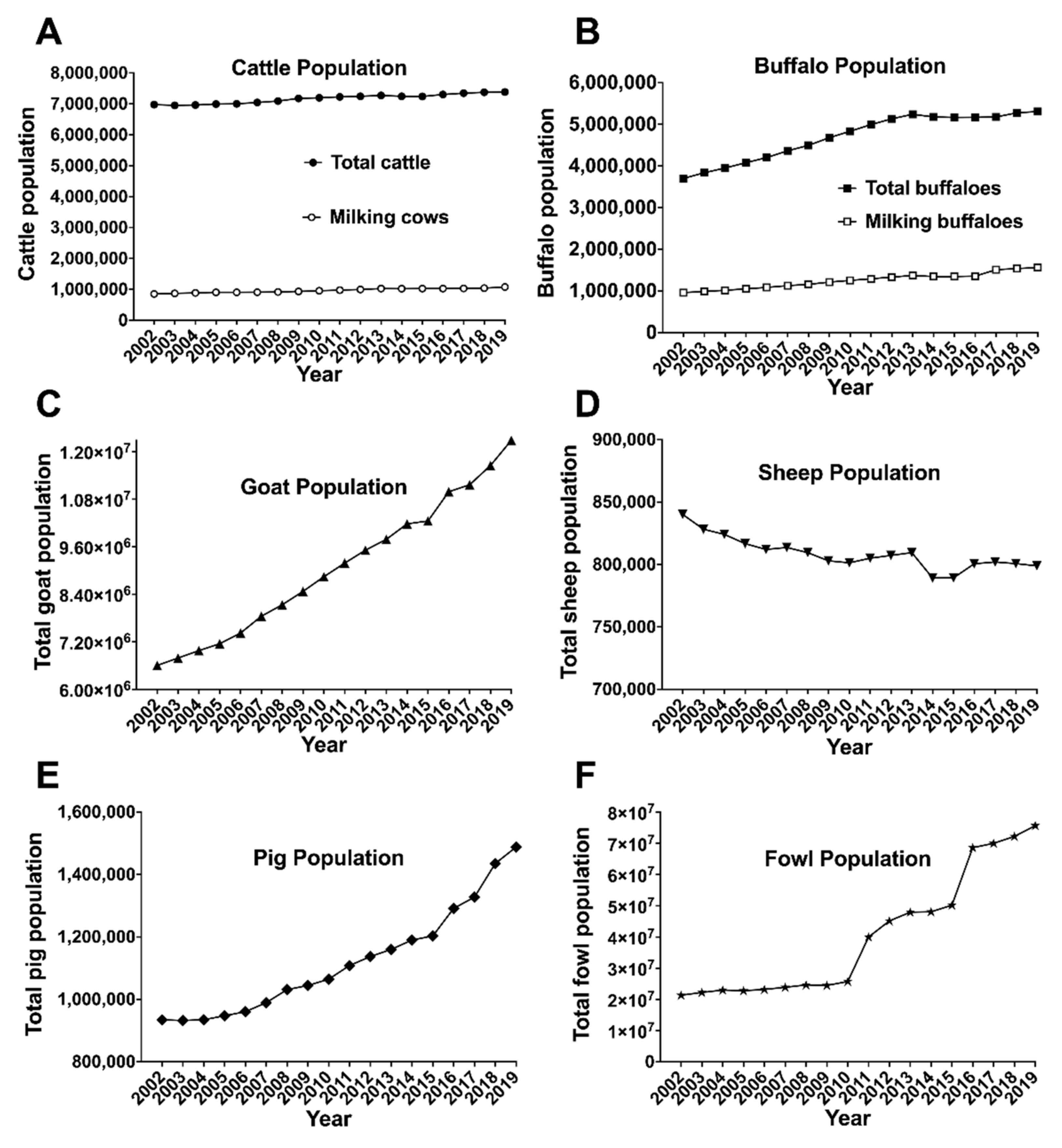
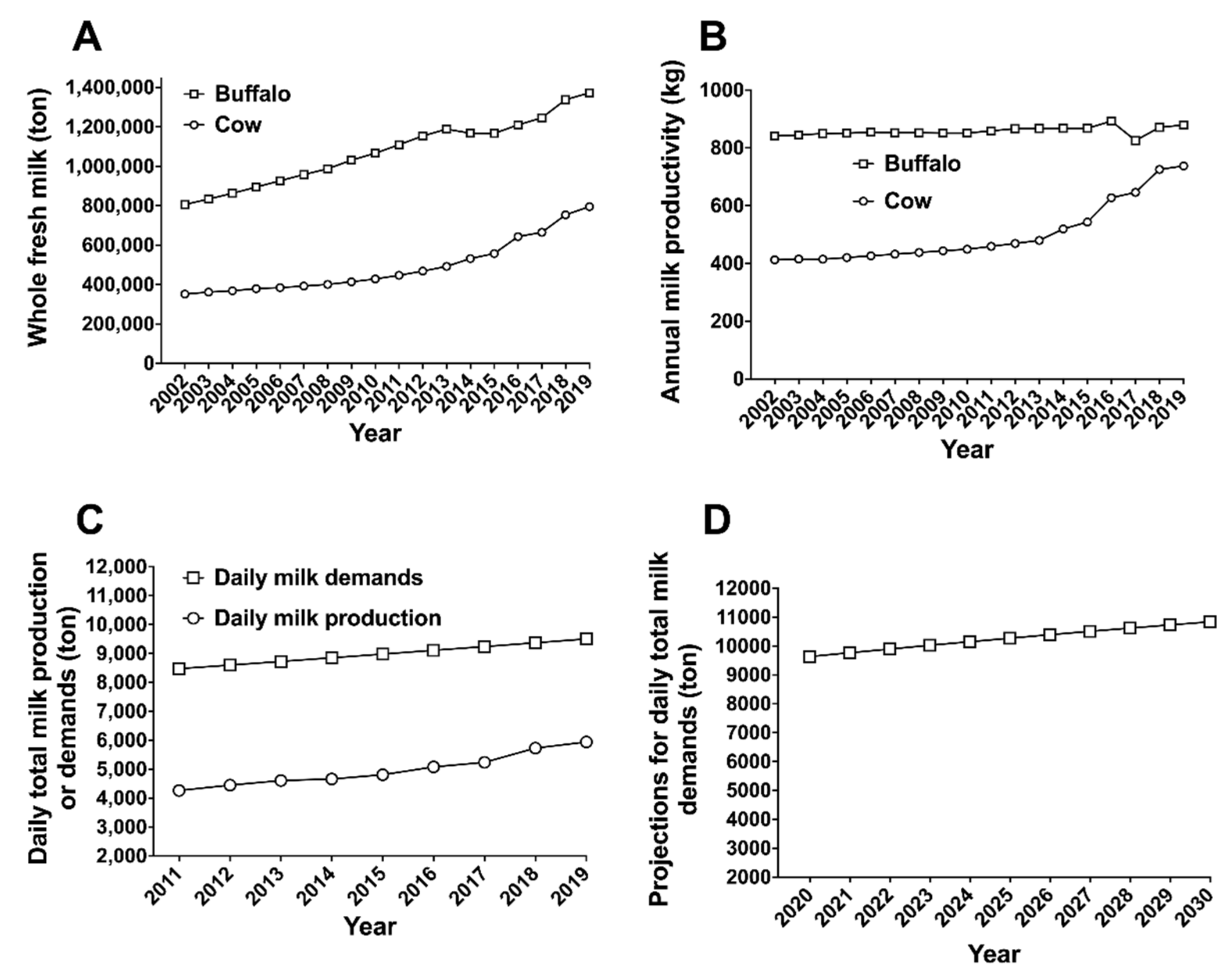
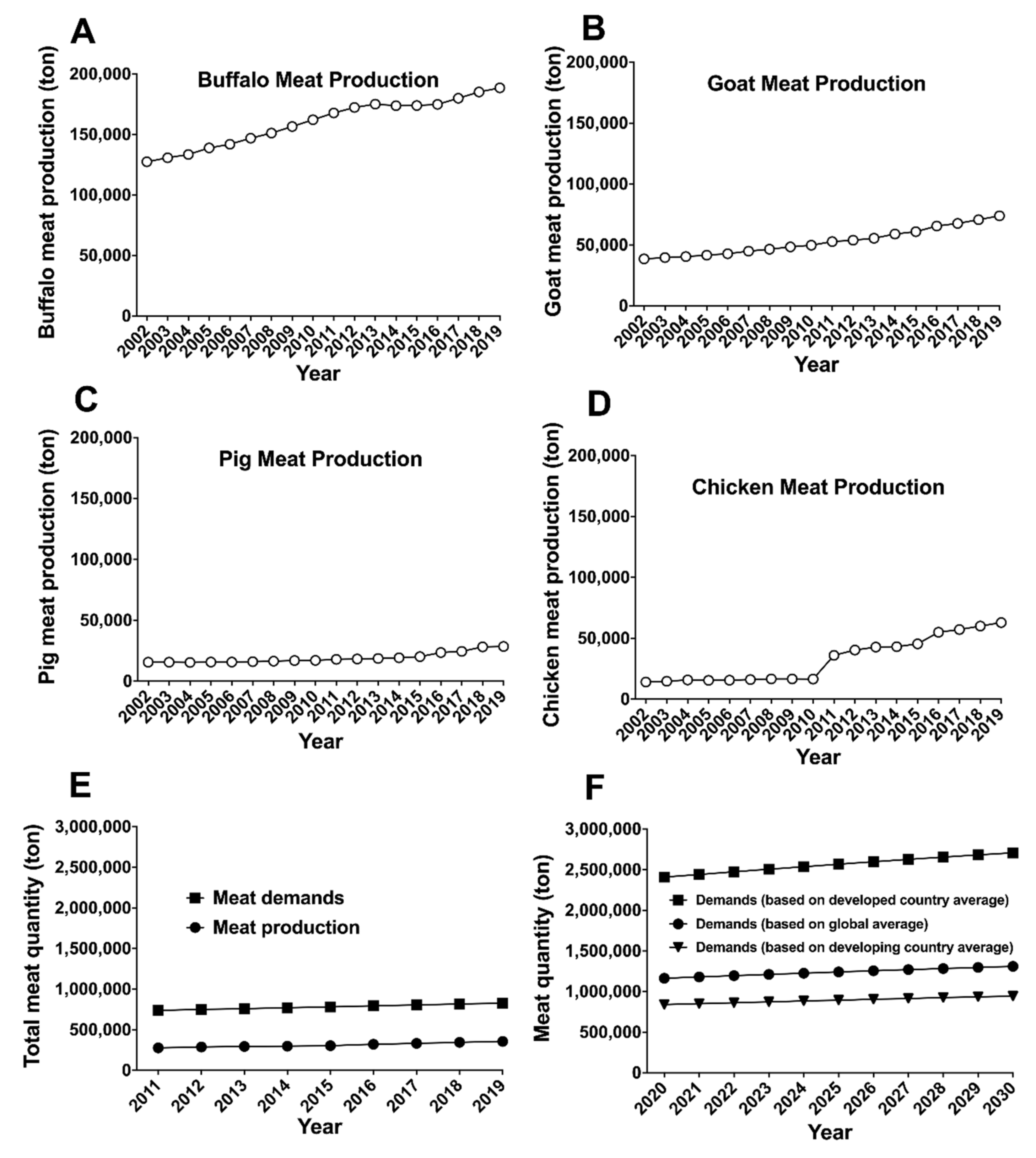
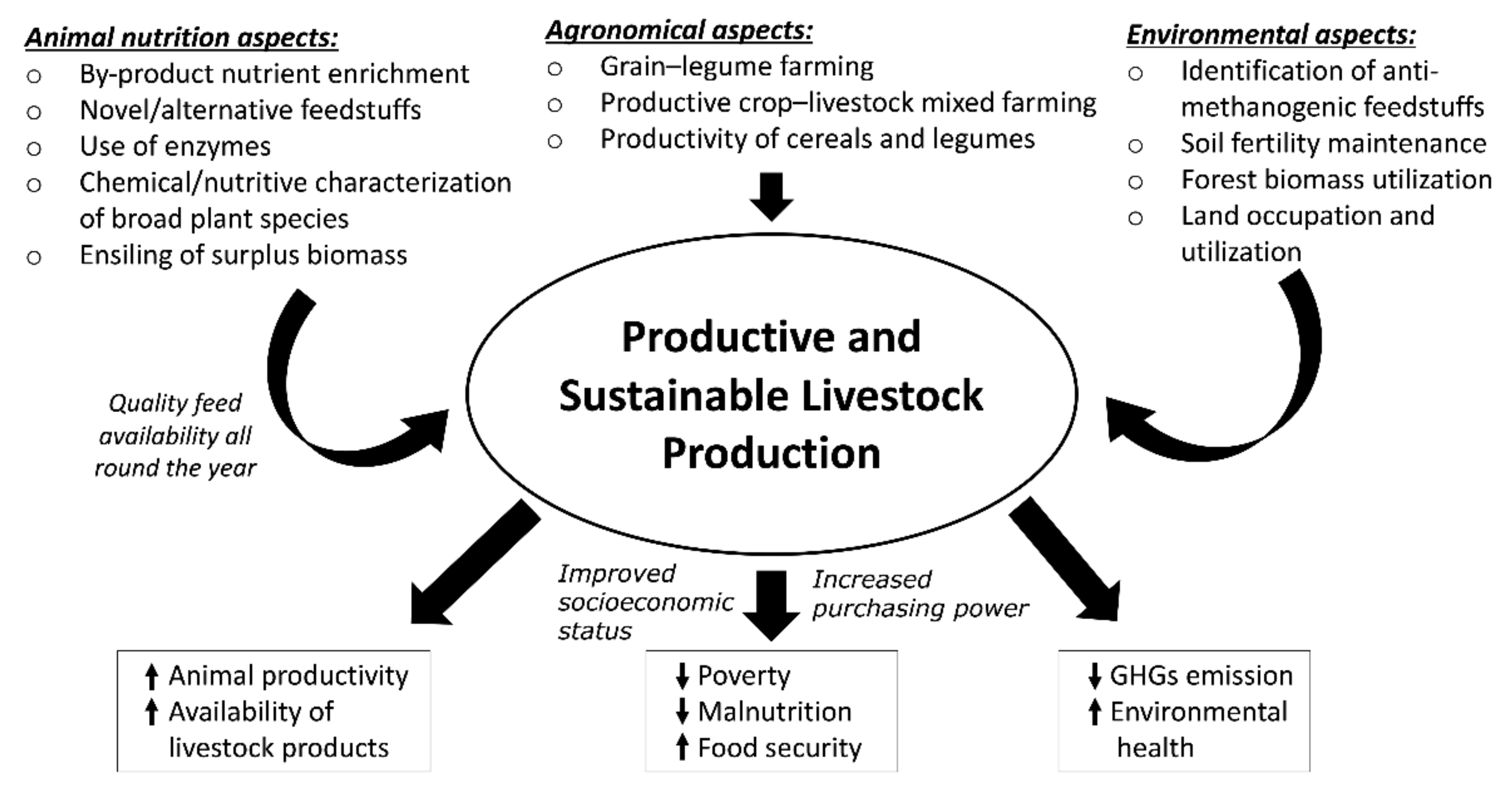
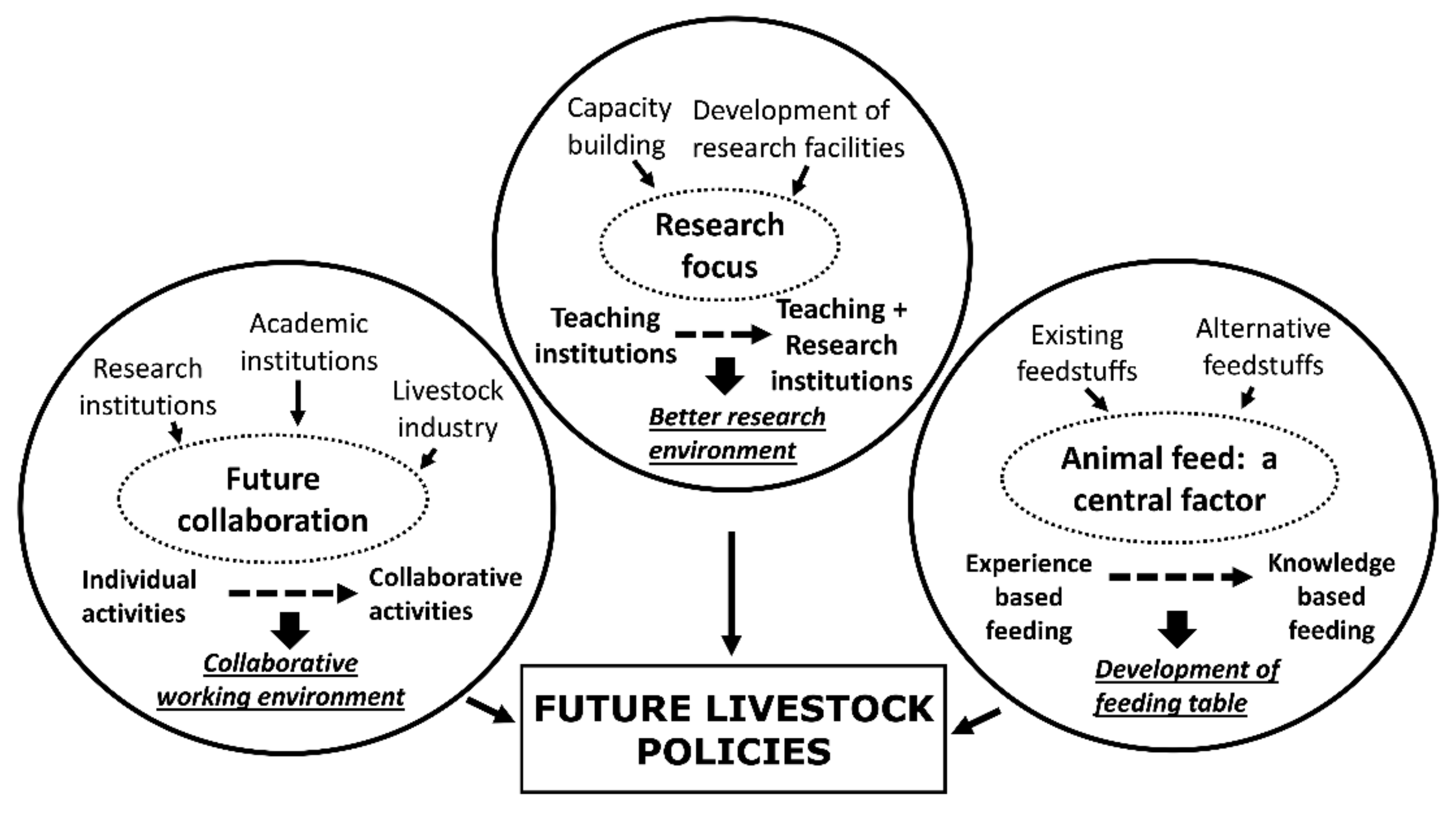
Publisher’s Note: MDPI stays neutral with regard to jurisdictional claims in published maps and institutional affiliations. |
© 2022 by the authors. Licensee MDPI, Basel, Switzerland. This article is an open access article distributed under the terms and conditions of the Creative Commons Attribution (CC BY) license (https://creativecommons.org/licenses/by/4.0/).
Share and Cite
Khanal, P.; Dhakal, R.; Khanal, T.; Pandey, D.; Devkota, N.R.; Nielsen, M.O. Sustainable Livestock Production in Nepal: A Focus on Animal Nutrition Strategies. Agriculture 2022, 12, 679. https://doi.org/10.3390/agriculture12050679
Khanal P, Dhakal R, Khanal T, Pandey D, Devkota NR, Nielsen MO. Sustainable Livestock Production in Nepal: A Focus on Animal Nutrition Strategies. Agriculture. 2022; 12(5):679. https://doi.org/10.3390/agriculture12050679
Chicago/Turabian StyleKhanal, Prabhat, Rajan Dhakal, Tanka Khanal, Deepak Pandey, Naba Raj Devkota, and Mette Olaf Nielsen. 2022. "Sustainable Livestock Production in Nepal: A Focus on Animal Nutrition Strategies" Agriculture 12, no. 5: 679. https://doi.org/10.3390/agriculture12050679
APA StyleKhanal, P., Dhakal, R., Khanal, T., Pandey, D., Devkota, N. R., & Nielsen, M. O. (2022). Sustainable Livestock Production in Nepal: A Focus on Animal Nutrition Strategies. Agriculture, 12(5), 679. https://doi.org/10.3390/agriculture12050679






